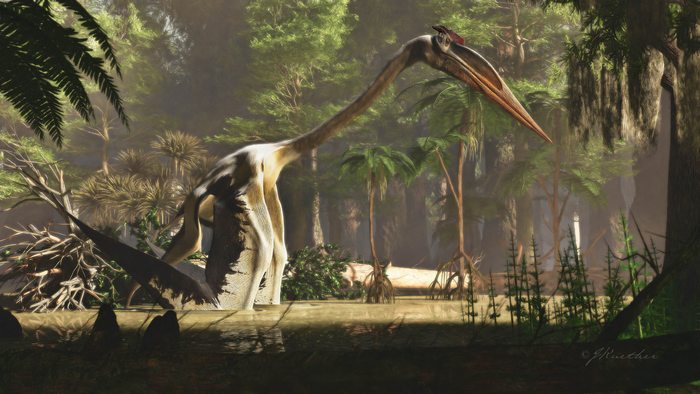Scientists decode how world’s largest-ever flying animal got airborne
Giant pterosaurs likely leaped, jumping at least 2.5 metres into the air before lifting off

Scientists have decoded the mystery of how a giant dinosaur that lived 67 million years ago learned to fly.
Paleontologists have known about the existence of the giant pterosaur Quetzalcoatlus that weighs over 250kg and has a wingspan of nearly 12 metres.
But how such a massive animal took to the sky during the age of the dinosaurs has remained a mystery.
The new findings, published in a collection of new studies in the Journal of Vertebrate Paleontology, however, now reveal how the mammoth beast ruled the skies for millions of years.
Researchers have speculated that the giant pterosaur rocked forward on its wingtips like a vampire bat while others suggested it could have built up speed by running and flapping like an albatross.
Some others have doubted the winged beast ever flew at all.
“These ancient flying reptiles are legendary, although most of the public conception of the animal is artistic, not scientific,” Kevin Padian, an emeritus professor and curator at the University of California (UC), Berkeley, said in a statement.
The findings suggested that the mammoth reptile would have been capable of flying with a jumping start, leaping at least 2.5m into the air before lifting off by sweeping its wings.
The pterosaur’s giant wings would have prevented it using a running start as they would have hit the ground, suggested the studies.
“This is the first time that we have had any kind of comprehensive study. Even though Quetzalcoatlus has been known for 50 years, it has been poorly known,” Matthew Brown, director of The University of Texas at Austin’s Vertebrate Paleontology Collections, said in a statement.
In the research, the scientists assessed giant pterosaur bones as well as those of a smaller species, the Quetzalcoatlus lawsoni, with a wingspan of about 6m.
The researchers reconstructed a nearly complete skeleton of the smaller species based of the biomechanical analysis of its bones.
They studied how the smaller species flew and moved and then applied their insights to its larger cousin.
“Pterosaurs have huge breastbones, which is where the flight muscles attach, so there is no doubt that they were terrific flyers,” Dr Padian, a co-editor of the research, said.
The study also highlighted the geological background of these reptiles, observing that the place these giant beasts called home was most likely an evergreen forest instead of the desert of today.
Based on this context, scientists said the larger Quetzalcoatlus might have lived like today’s herons, hunting alone in rivers and streams.
They said the smaller species, in contrast, may have flocked together in lakes either year-round or seasonally to mate, with at least 30 individuals found at a single fossil site.
“Never before has so much detailed information on azhdarchids [the pterosaur family that includes Quetzalcoatlus] been gathered in the same place, this meaning that the work will serve as the standard go-to study of this group for years – probably decades – to come,” Darren Naish, a pterosaur expert who was not involved with the research, said in a statement.
The scientists also speculated that the reptile likely used its long, toothless jaws to sift for crabs, worms and clams from river bottoms and lakebeds.
“This is the first real look at the entirety of the largest animal ever to fly, as far as we know. The results are revolutionary for the study of pterosaurs – the first animals, after insects, ever to evolve powered flight,” Dr Padian added.
Join our commenting forum
Join thought-provoking conversations, follow other Independent readers and see their replies
Comments
Bookmark popover
Removed from bookmarks